| PEDO DE LUNATIC, AKA POPE BENEDICT XIII, WAS THE FIRST SPANISH . . . AND MUSLIM POPE!! |
|---|
The history of the era beginning with the Avignon Popes is so complicated that it would require a super computer to keep track of all the Popes that reigned during those dark days. Here is a CHART that will help you keep track of them.
It is beyond belief, but the Avignon Pope Benedict XIII is listed as an ANTIPOPE, while his Avignon predecessor, Pope Benedict XII, is considered a legitimate Pope.
Prior to the 7 Avignon Popes, the Papacy was just a football to be kicked about by England and France. Depending on which country had possession of the ball, that country "elected" their Popes, and manipulated Papal policy in their favor.
All that changed during the 70-year Avignon era and the "suppression" of the Knights Templar fighting monks. 3 new countries emerged out of the darkness and chaos of that bloody time: Switzerland, Portugal, and Spain. The Templars created Spain by uniting the kingdoms of Aragon and Castile.
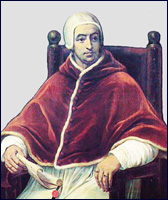
Pope Benedict XIII (1328–1423).
Pope from 1394 to 1423. |
|
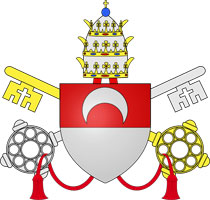 Pope Benedict's coat of arms with the Muslim crescent moon. |
That was the beginning of the Western Schism or the Papal house divided which continues to this very day!!
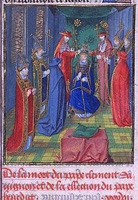 Crowning of Pope Benedict XIII at Avignon, Oct. 11, 1394. |
|
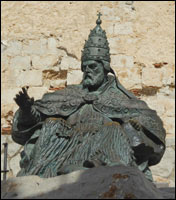 A modest monument to Benedict XIII on the Rock of Peñiscola. |
Pedro was a canon lawyer by profession and not even a priest at that time. He quickly found a cardinal to ordain him a priest and bishop after he became Pope.
Pope Benedict was recognized as the legitimate Pope by the following countries: France, Scotland, Castile, Aragon, Navarre and Portugal. His predecessor, Pope Clement VII, had just met a timely death, so Pedro promised to resign immediately after his crowning . . . if his counterpart in Roma, Pope Boniface IX, resigned also.
Pope Benedict XIII withstood a 4.5 year siege in the Palace of the Popes!
The massive Palace of the Popes was built by Pope Benedict XII. It was almost as if he was prescient and knew the future.
When Benedict was crowned in October 1394, the Pope in Roma was Pietro Tomacelli, aka Pope Boniface IX. Pope Benedict promised to resign right away after his election . . . if Pope Boniface also resigned. Of course, he had no intention of ever resigning.
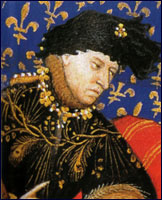 King Charles VI (1368–1422). King from 1380 to 1422. |
|
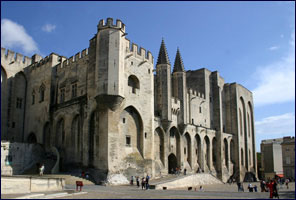 The massive Palace withstood a 4.5 year siege. |
The king sent one of his top generals, Marshal Boucicault, who boasted that within days he would be bringing Benedict back to Paris in chains. The siege began on September 22, 1398:
Boucicault led his troops into Avignon on September 22, 1398, and took over the city, replacing Cardinal Jean de Neufchâtel and proving to the citizens that they had not bought peace by turning coats. His men seized the house of Cardinal Pérez, one of Benedict's loyal five. (Gail, The Three Popes, p. 129).
The garrison of the Vicar of the "Prince of Peace," augmented by his Spanish Knights Templar, made a ferocious defense of the Palace. By the middle of November, Marshall Boucicault was relieved of his command and replaced with Georges de Marle, Seneschal of Provence. He had no better success that his predecessor.
As the siege dragged on, many saw the defense of the Palace as supernatural, and public opinion in France began to turn back once more to Benedict as the legitimate Pope:
On the night of March 11, 1403, Benedict made his escape from the Palace disguised as a Carthusian monk: Fear nothing was his last goodbye to them. Then he turned and started down the narrow way. He reached the hidden opening, carefully felt his way through. Nine years before, as Pope, he had entered this Palace with panoply and splendor, the trumpet blowing triumph. Those years were gone in a single breath and here he was, creeping out like a thief in the night. (Gail, The Three Popes, p. 152).
One of the main supporters of Pope Benedict was a Dominican monk and Inquisitor named Vincent Ferrer.
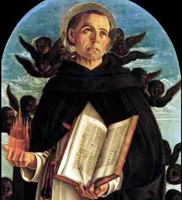 Dominican friar Vincent Ferrer (1350–1419). |
|
 Joan of Arc (1412–1431). |
Many people were burned alive at the stake for choosing the "wrong" Pope. Joan of Arc prolonged the controversy by supporting Pope Benedict and that was the real reason why she was burned alive at the stake.
In November 1415, after many peregrinations, Pope Benedict finally ended up on the Rock of Peñiscola—a castle built by the Knights Templar. He was 87-years-old but still as feisty and stubborn as an Andalusian mule.
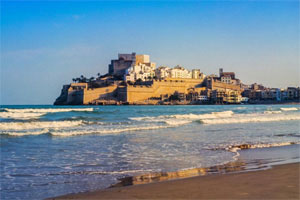 The Rock of Peñiscola where Pope Benedict spent his final days. |
|
 Pope Martin V (1369–1431). Pope from 1417 to 1431. |
Just 2 years after Benedict arrived at Peñiscola, the Council of Constance excommunicated him, and elected Otto Colonna, who took the name Martin V:
Constance declared Pedro de Luna among other things "a man rejected by God," forbade him "to represent himself as Pope," absolved all Christians of oaths sworn to him before, and cut off any man, ecclesiastic or lay, who should support him or give him asylum, "on pain of being deprived of their benefices" (Gail, The Three Popes, p. 273).
According to their own canon law, only a legitimate Pope could call a council. Benedict never authorized that council so all its enactments were illegal. Furthermore, any cardinals created by Pope Martin would be ineligible to vote in a Papal election.
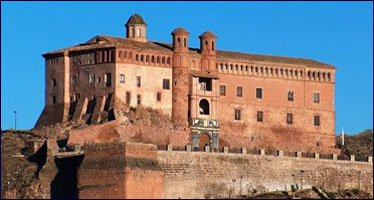
Pope Benedict was buried in the Palace
of
Illueca, Zaragoza, in the kingdom of Aragon. |
|
 A replica of his skull is on display at St. Andrews University in Scotland. |
Scotland was one of the countries that supported Pope Benedict so a replica of his skull is on display at St. Andrews University in Scotland.
The day before his death, Benedict appointed four cardinals of proven loyalty to ensure the succession of another Pope who would remain faithful to the newly created Spanish Papal dynasty. Three of these cardinals met on June 10, 1423, and elected Sanchez Muñoz as their new Pope, with Muñoz assuming the papal name of Clement XIV.
The fourth cardinal, Jean Carrier, the archdeacon of Rodez near Toulouse, was absent at this conclave and disputed its validity, whereupon Carrier, acting as a sort of one man College of Cardinals, proceeded to elect Bernard Garnier, the sacristan of Rodez, as Pope, with Garnier taking the name Benedict XIV.
Pope Callixtus III was the second Spanish Pope!
Alfons de Borja (Borgia in Italian) was the founder of the Borgia dynasty. He took the name Callixtus III went he was crowned Pope at Roma.
One of the highlights of his Papacy was the canonization of Vincent Ferrer and the attempted canonization of Joan of Arc.
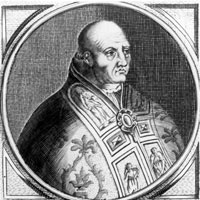 Pope Callixtus III (1378–1458). Pope from 1455 to 1458. |
|
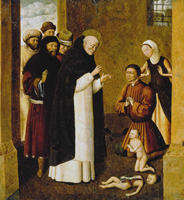 Vincent Ferrer (1350–1419). |
Joan of Arc was convicted of heresy by the English and burned at the stake for supporting the "schismatic" Pope Benedict. Callixtus had that verdict changed but he couldn't bring her back to life again. He went to meet his Maker before he could have her declared a Papal saint.
Pope Alexander VI—the infamous Rodrigo Borgia was the third Spanish Pope!
Rodrigo Borgia, aka Pope Alexander VI, needs no introduction. He not only committed the 7 deadly sins on a daily basis, but 70 deadly sins. He was the Pope that "donated" the New World to Spain.
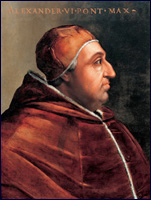 Pope Alexander VI (1431–1503). Pope from 1492 to 1503. |
|
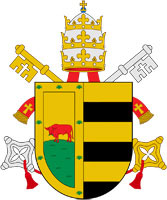 Coat of arms of Pope Alexander VI with the Bull and keys of Romulus and Remus. |
Here is a brief excerpt from the Inter Caetera Bull:
Furthermore, under penalty of excommunication late sententie to be incurred ipso facto, should anyone thus contravene, we strictly forbid all persons of whatsoever rank, even imperial and royal, or of whatsoever estate, degree, order, or condition, to dare, without your special permit or that of your aforesaid heirs and successors, to go for the purpose of trade or any other reason to the islands or mainlands, found and to be found, discovered and to be discovered, towards the west and south, by drawing and establishing a line from the Arctic pole to the Antarctic pole, no matter whether the mainlands and islands, found and to be found, lie in the direction of India or toward any other quarter whatsoever, the said line to be distant one hundred leagues towards the west and south, as is aforesaid, from any of the islands commonly known as the Azores and Cape Verde; apostolic constitutions and ordinances and other decrees whatsoever to the contrary notwithstanding. (Inter Caetera Bull of 1493).
Borgia's own son Cesare was known as "The Strangler." During mass he would slip behind one of his victims and strangle him in the pew. His sister Lucrezia was known as "The Poisoner."
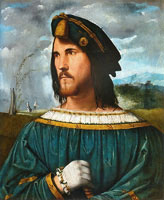 Cesare Borgia (1476–-1507). |
|
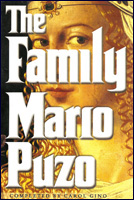 The "Borgia" Family by best selling author Mario Puzo. |
Millions of Catholics watched the blockbuster Godfather movies, never realizing that they were watching the deadly antics of their own "Holy Father" and his crime family.
After Borgia—Pope Julius II banned Catalan or Spanish Popes forever!
Cardinal Giuliano della Rovere fully expected to be Pope in 1492 following the timely death of Pope Pius III. That never happened because Borgia bought the Papacy. During his Pontificate, Alexander tried many times to poison the cardinal but all his attempts failed.
When he became Pope, Julius vowed that Catalans or Spaniards would be banned from the Papacy forever. He never published a Bull to that effect, but it was an unwritten law that guided the Conclaves down through the centuries.
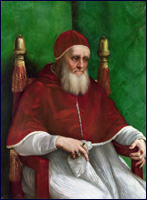 Pope Julius II (1453–1513). Pope from 1503 to 1513. |
|
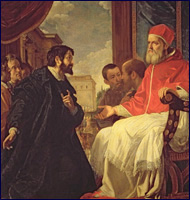 The "Warrior Pope" conferring with sculptor Michelangelo. |
Here is a quote from The Family by Mario Puzo:
The night of Alexander's death, armed mobs surged through the streets of Rome, beating and killing anyone of Spanish descent—Catalans, as they were called—and looting all their homes. (Puzo, The Family, p. 345).
Cesare Borgia managed to survive the poisoned wine and a Borgia puppet named Francesco Piccolomini became Pope as Pius III. He only survived for 26 days, and he still holds the record for the shortest lived Pontiff in history.
Immediately after the death of Pius III, Giuliano della Rovere became Pope as Julius II. He hated the ground that the Borgias walked on. He closed the Borgia apartments and they remained closed until the 19th century.
To avoid the ban on Spaniards, the Jesuits created a TWIN or parallel Papacy!
To circumvent the ban on Catalans or Spanish Popes, the Jesuits created a TWIN or shadow Papacy
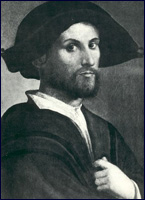 Juan Borgia (1474–1497). |
|
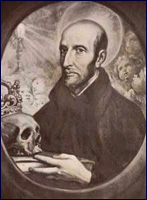 Francis Borgia (1510–1572). Jesuit general from 1565 to 1572 |
With the help of the fanatical Knights Templar, the Spanish expelled the Muslims from Spain, and then went on to conquer the New World. Millions of New World natives perished and the gold and silver mines of Mexico and Peru were opened to Spanish exploitation.
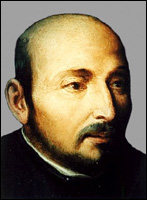 Ignatius Loyola (1491–1556). Black Pope from 1541 to 1556. |
|
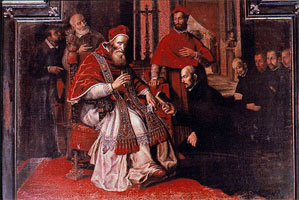 Pope Paul III officially recognizing the Pope Paul III officially recognizing the Jesuits as a new Order. |
The Jesuits were fighting monks like the Knights Templar, and the position of Jesuit general was equivalent to the Templar's Grand Master. Unlike the Templars, the monks did not have to live in monasteries and wear the round tonsure and red cross.
Their "civilian dress" made them excellent spies and soon they had infiltrated most of the ruling houses of Europe and Asia.
Spain almost achieved worldwide hegemony during the 16th century!
It wasn't a "miracle" that the Spanish pikemen became the terror of the entire world. They were augmented by the "suppressed" Knights Templar fighting monks.
King Charles V was a latter days counterpart of the tyrannical King Nebuchadnezzar of Babylon, who ordered the furnace heated 7 times hotter for Shadrach, Meshach, and Abednego (Daniel 3:19).
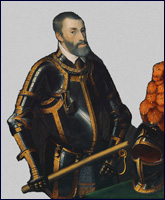 King Charles V (1500–1558). King from 1516 to 1556. |
|
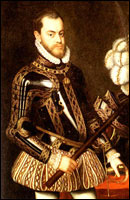 King Philip II (1527–1598). King from 1556 to 1598. |
King Philip was a latter day counterpart to the genocidal Haman in the Book of Esther who planned on exterminating all the Jews in the Persian Empire.
Philip was married to Bloody Mary Tudor who burned over 500 Christians alive at the stake. In 1572, he orchestrated the dreadful Saint Bartholomew's Day Massacre, and his crowning folly was the 1588 "Invincible Armada."
The Jewish Messiah promised that the gates of Hades would not prevail against his Congregation, so he raised up faithful Christians at that time also.
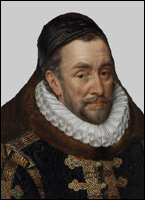 William Prince of Orange (1533–1584). |
|
 Sir Francis Drake (1542–1598) circa 1577. |
Sir Francis Drake defied the Bull of Borgia and tried to establish British colonies in the New World. He received absolutely no help from Queen Elizabeth I. Sir Francis was one of the heroes of the defeat of the "Invincible Armada."
Drake was a rich man after his circumnavigation of the world but he continued to fight the Spanish Inquisition to the very end of his life.
While on an expedition against the Spanish in the West Indies, Drake was poisoned by a Spanish agent aboard his ship, and he was unceremoniously dumped overboard, and buried at sea. Sir Francis Drake is now rejoicing in Heaven and the sea will gave up his body when Gabriel blows the great TRUMPet on the Last Day!!